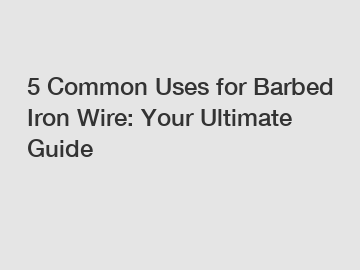Is Wire Mesh Necessary in a Concrete Driveway?
May. 13, 2024
Is Wire Mesh Necessary in a Concrete Driveway?
If you are looking for more details, kindly visit Crimped wire mesh for concrete forms.
Concrete roadways, platforms, and structures typically require some type of reinforcement to help reduce cracking and prevent architectural failure. Most often, rebar (steel bars) are embedded into the concrete before it hardens. However, galvanized panels of welded wire mesh can be used as an alternative to rebar.
If you're planning to repave your driveway, you should definitely consider using steel reinforcement. Since weighty industrial vehicles probably won't be driving on your property very often (or ever), rebar might be overkill for a residential project. In that case, is wire mesh necessary in a concrete driveway? Experts recommend using heavy-duty wire mesh on private roadways. Here's why.
Why Use Wire Mesh In Concrete?
As long as a driveway or parking lot isn't regularly driven on by semi trucks and other heavy vehicles, welded wire mesh will work well. If you're like a lot of homeowners, you might be wondering if you can go without steel reinforcement altogether. While there are some exceptions, reinforcing a driveway is generally worth the investment.
Heavy-gauge welded wire mesh panels are:
- Easy to lay in the desired position
- Exceptionally durable with a high tensile strength
- More affordable than rebar
- Positioned much faster than rebar
- Preassembled
Unlike some rebar grids, you can count on the consistent size and spacing of galvanized wire mesh. Additionally, as the concrete is being poured, stainless steel mesh panels stay in position.
When it comes to concrete, you can't avoid cracks entirely, but wire mesh reinforcement will help hold the material together when they do occur. Also, it will help evenly distribute the weight of cars on your driveway. The added strength of steel is especially crucial if your subgrade isn't up to par.
How Do You Attach Wire Mesh to Concrete?
Whether you're hiring a contractor or are planning to tackle the project yourself, it's helpful to have a general idea of the process. Find the basic steps of reinforcing a concrete driveway below.
First, you'll need to install your forms, which will essentially frame the driveway and keep the concrete in place before it sets.
Next, you'll use gravel or another fill material to even out the grade.
After compacting the fill into the subgrade, it's time to add steel reinforcement.
Position the wire mesh about two inches from the forms, using heavy-duty wire cutters to cut the edges as needed. If possible, get wire mesh paneling pre-cut to size so you can lay it directly on top of the fill with minimal adjustments.
Once the wire mesh is in place, you can pour the concrete, flatten it, level it, and then cure it.
High-Quality Wire Mesh for DIY Projects
For over 50 years, TWP Inc. has been a trusted supplier of industrial-grade steel wire mesh. Our women-owned business is proud to serve construction companies, infrastructure firms, homeowners, and DIYers alike. As an ISO-certified company, our customers can rest assured they're getting top-tier materials, services, and support.
We carry galvanized and welded stainless steel wire mesh suitable for concrete reinforcement. Not only that, but with our in-house measuring, laser cutting, and roll slitting services, you can get the exact size you need for your driveway.
Order your stainless steel wire mesh today, or request a quote for a custom size or quantity. Want to have your new driveway featured in TWP Inc.'s online gallery? Upload your photos to Instagram using the hashtag #TWPWireMesh.
Understanding Wire Mesh Weaving Methods
Wire mesh weaving is a specialized process that involves interlacing wires to form a mesh structure. The accuracy and precision of this process are critical in determining the quality and functionality of the resulting mesh. This article aims to delve into the significance of precision and accuracy in wire mesh weaving methods.
Unlocking the Magic of Jiushen Epoxy Mesh
Unleashing the Benefits of Using Galvanized Sheets For Sale
Galvanized Chain Link Mesh vs Traditional Fencing: A Comparison
Advantages and Disadvantages of Steel Doors & Windows
Ultimate Guide to 358 Security Fence Prices
10 Things You Need to Know About 656 Double Wire Fence
4 Pieces of Advice on Choosing a Window Screen Mesh Replacement
For more Double Crimped Wire Meshinformation, please contact us. We will provide professional answers.
Kunyu’s Wire Mesh
Introduction of Wire Mesh Weaving
Wire mesh weaving is a fundamental technique in manufacturing wire meshes used in various industries. Precision plays a pivotal role in the production of wire meshes, as it ensures the structural integrity, durability, and functionality of the final product.
Basics of Wire Mesh Weaving
Wire mesh weaving is a meticulous process involving the interlacing of metal wires, typically made of stainless steel or other metals, to form a mesh structure. This intricate process is executed on looms, where wires are arranged in warp (longitudinal) and weft (transverse) directions.
- Plain Weave: The most common weaving method where each wire passes alternately over and under the adjacent wires in both directions, resulting in a square or rectangular pattern.
- Twill Weave: Involves wires passing over two and under two adjacent wires in a staggered pattern, creating diagonal lines or patterns, offering higher strength and durability.
- Dutch Weave: A type of twill weave characterized by thick warp wires and thin weft wires, creating a tighter mesh suitable for fine filtration applications.
- Wire Selection: The choice of wire diameter and material significantly influences mesh characteristics, including tensile strength, corrosion resistance, and flexibility.
- Mesh Size and Configuration: Determined by the number of wires per inch or millimeter, impacting the mesh's openness, filtration capacity, and structural integrity.
- Weaving Process: Typically conducted on automatic or semi-automatic looms that precisely arrange wires in a specific pattern. Skilled operators monitor the looms to ensure accuracy in weaving.
- Specialized Weave Patterns: Apart from the standard weaves, specialized patterns like multi-layer, reverse, or segmented weaves are employed for specific applications, offering unique properties like enhanced filtration or increased durability.
Understanding Precision in Wire Mesh Weaving
Precision in weaving holds paramount importance in the production of wire mesh as it dictates the final quality and functionality of the mesh. Achieving precision involves meticulous control over various parameters such as wire diameter, spacing, and weaving techniques. Each wire's diameter and spacing determine the mesh's structural integrity and uniformity, impacting its strength, filtration properties, and overall performance.
Moreover, the precision in weaving extends beyond individual wire elements. It encompasses the overall process, including the tension control of the wires during weaving, the speed of the loom, and the expertise of the workforce. Consistency in tension and weaving speed ensures uniformity, while skilled artisans play a vital role in maintaining precision through careful handling and supervision of the weaving process. Precision is not merely an outcome; it's a systematic and calculated approach that ensures each wire interlocks precisely to create a mesh structure that meets stringent industry standards and specific application requirements.
Techniques and Methods in Wire Mesh Weaving
Wire mesh weaving involves several techniques and methods aimed at achieving precision and accuracy in the final product. The choice of weaving technique significantly impacts the mesh's characteristics. Plain weave, for instance, is the most common method where wires are woven in a simple over-and-under pattern, offering stability and strength. Twill weave, on the other hand, interlaces the wires in a diagonal pattern, providing increased flexibility and allowing for finer meshes. Dutch weave employs two different wire diameters, resulting in fine filtration capabilities suitable for intricate applications like hydraulic systems.
Moreover, the process can be manual or automated, with varying levels of complexity. Advanced automated looms utilize computer-controlled systems for consistent and precise weaving. These machines allow for intricate designs, minimize human error, and increase production rates significantly. Skilled craftsmanship also remains crucial, especially in intricate or customized mesh requirements, where manual techniques are essential for achieving specific patterns or designs. Calibration of weaving machinery, regular maintenance, and adherence to standard operating procedures are fundamental aspects to ensure optimal precision in wire mesh weaving.
Factors Influencing Accuracy in Wire Mesh Weaving
Factors influencing accuracy in wire mesh weaving encompass various aspects, including wire material quality, loom calibration, tension control, and workforce expertise. The quality of the wire used significantly impacts the precision of the final mesh, where uniformity in wire diameter and composition is crucial. Additionally, the calibration of weaving machinery ensures consistent spacing and tension among the wires during the weaving process, directly affecting the mesh's accuracy. Skillful and experienced operators adept at managing machinery intricacies and maintaining ideal weaving conditions further contribute to achieving precise wire mesh output. These factors collectively play a pivotal role in ensuring the accuracy and quality of the woven wire mesh.
Quality Assurance in Wire Mesh Weaving
Quality assurance in wire mesh weaving encompasses a series of meticulous processes and checks to maintain the desired precision and accuracy. It involves stringent inspections of raw materials, such as wire gauge and quality, ensuring they meet specified standards. Additionally, regular maintenance and calibration of weaving machinery are imperative to uphold consistent tension control and weaving speed. Throughout the weaving process, continuous quality checks are conducted to monitor parameters like wire spacing, diameter, and mesh size, ensuring they adhere precisely to the required specifications. These comprehensive measures collectively ensure that the woven wire meshes meet the highest quality standards and perform effectively in their intended applications.
Applications of Precise Wire Mesh
Applications of precise wire mesh span across multiple industries due to their high-quality and accuracy. In aerospace, these meshes are utilized for filtration systems and shielding due to their resilience and fine filtration capabilities. Pharmaceutical sectors benefit from their use in precise sieving and filtering processes to ensure quality control. The automotive industry employs these meshes in catalytic converters and exhaust systems owing to their heat resistance and durability. In construction, they find usage in reinforcing concrete structures. Additionally, these meshes are pivotal in filtration systems, water treatment, food processing, and security fencing due to their versatility and reliability.
Kunyu's Superiority in Precision Weaving
Precision and accuracy in wire mesh weaving are indispensable for producing high-quality meshes that meet diverse industry needs. Adhering to precise weaving methods ensures that wire meshes fulfill their intended functions effectively.
Kunyu‘s Production Workshop
Kunyu Wire Mesh Co., Ltd. exemplifies the pinnacle of precision and accuracy in wire mesh weaving. With an unwavering dedication to innovation and advanced weaving techniques, Kunyu consistently delivers wire mesh products that surpass industry standards. The company's commitment to employing cutting-edge machinery, skilled craftsmanship, and stringent quality control measures ensures the production of wire meshes of unparalleled quality. Kunyu's emphasis on high zinc coating for anti-rust properties, ease of installation, cost-effectiveness, and exceptional aesthetics underscores its position as a premier provider of wire meshes, offering durability, security, and visual appeal.
#WireMesh #StainlessSteelWireMesh #InsectScreen #SecurityScreens #WindowScreens #DoorScreens #MeshSolutions #MeshTechnology #WindowMesh #DoorMesh #SecurityMesh #IndustrialMesh #Stainless #CommercialScreens #ResidentialScreens #ScreeningSolutions #MeshIndustry #WindowProtection #DoorProtection #ScreeningSystems #HomeSecurityScreens #BusinessSecurityMesh #WindowScreenInnovation #NextGenMeshSolutions #AdvancedScreening #MeshTechnology #InsectScreening #MeshInnovation #WindowScreenUpgrade #SecurityScreens #ModernMeshSolutions #InvisibleMesh #WeatherResistantScreens #HomeVentilation #CustomScreens #DIYWindowScreens #SteelWireMesh #B2B #chinafactory #chinamanufacturer #chinasupplier #madeinchina #wiremesh #FineMesh #MetalMesh #mesh #wire #wirerope #fence #metalmesh #WireMeshfactory
Are you interested in learning more about wholesale self cleaning mesh? Contact us today to secure an expert consultation!
How to Choose Roll Top Fencing Systems? A Comprehensive Guide
2.4m High 656 Twin Wire Mesh Security Fencing from £ ...
Ultimate Guide: Mosquito & Fly Proof Mesh
Revolutionizing Security: Diamond Wire Mesh Gates Benefits?
What are the three types of wire fences?
The Ultimate Guide to Hot Rolled Mild Steel Sheet: Everything You Need to Know
Ultimate Guide to Temporary Steel Fence: Installation, Cost & Benefits
85
0
0
Related Articles
-
What is the best way to secure window screens?
Are you looking for the best way to secure your window screens?
128
0
0
-
Ultimate Guide to Installing Barbed Wire Fencing: Answers to Your Top Questions
Ultimate Guide to Installing Barbed Wire Fencing: Answers to Your Top Questions.
123
0
0
-
140
0
0
-
123
0
0
-
7 Unique Ways to Customize Metal Window Screens
Are you tired of staring at plain, boring metal window screens in your home or office?
98
0
0
-
111
0
0
-
107
0
0
-
118
0
0










Comments
All Comments (0)